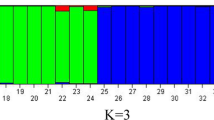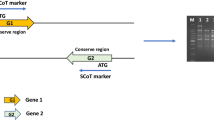Abstract
The researches on yak genetics and breeding were extremely restricted due to lacking of reliable DNA molecular markers. The microsatellites with repeat motif (AC)n/(GT)n in yak genome were enriched by Dynal magnetic beads and the gene libraries containing (AC)n/(GT)n were constructed. Among the 92 identified and sequenced positive clones, 40 contained perfect repeats (43.48 %), 41 contained imperfect repeats (44.57 %) and 11 contained compound repeats (11.96 %). As compared with the percentage of perfect repeats, no significant increases of imperfect repeats were observed in yak genome, which indicated that the level of adaptive evolution of the ability to repair damaged genomic DNA for yaks were high enough to endure the natural pressure of nucleotide substitution resulted from ultraviolet irradiation in high-altitude areas. Totally 19 polymorphic microsatellite loci were screened and genotyped on the basis of electropherograms on an ABI 310 Genetic Analyzer. All the loci exhibited moderate to high-level polymorphisms in a test population of Bos grunniens and the polymorphic information content ranged from 0.299 to 0.861 (mean 0.678). The newly isolated (AC)n/(GT)n repeats from yak genome will display their potential values in examining intra-population genetic structure and inter-population relationships, and also in investigating molecular markers for production and adaptive traits of individual/population.


Similar content being viewed by others
References
Cai X, Mipam TD, Zhang HR et al (2011) Abundant variations of MC4R gene revealed by phylogenies of yak (Bos grunniens) and other mammals. Mol Biol Rep 38:2733–2738
Behl R, Behl J, Gupta N et al (2007) Genetic relationships of five Indian horse breeds using microsatellite markers. Animal 1:483–488
Ren DR, Yang QY, Ye JH et al (2009) Strong heterozygote deficit in Tibetan Mastiff of China based on microsatellite loci. Animal 3:1213–1215
Boitard S, Chevalet C, Mercat MJ et al (2010) Genetic variability, structure and assignment of Spanish and French pig populations based on a large sampling. Anim Genet 41:608–618
Nguyen TT, Genini S, Menetrey F et al (2005) Application of bovine microsatellite markers for genetic diversity analysis of Swiss yak (Poephagus grunniens). Anim Genet 36:484–489
Qi XB, Han JL, Lkhagya B et al (2005) Genetic diversity and differentiation of Mongolian and Russian yak population. J Anim Breed Genet 122:117–126
Qi XB, Han JL, Wang G et al (2009) Assessment of cattle genetic introgression into domestic yak populations using mitochondrial and microsatellite DNA markers. Anim Genet 41:242–252
Li QF, Zhao XB, Luo XL et al (2004) Construction and identification of enriched microsatellite library from yak genome. Acta Genetica Sinica 31:489–494
Li Q, Wan JM (2005) SSRHunter: development of a local searching software for SSR sites. Hereditas (Beijing) 27:808–810
Rozen S, Skaletsky HJ (2000) PRIMER 3 on the WWW for general users and for biologist programmers. In: Krawetz S, Misener S (eds) Bioinformatics methods and protocols: methods in molecular biology. Humana Press, Totowa, pp 365–386
Kalinowski ST, Taper ML, Marshall TC (2007) Revising how the computer program CERVUS accommodates genotyping error increases success in paternity assignment. Mol Ecol 16:1099–1106
Raymond M, Rousset F (1995) GENEPOP (version 3.4): population genetics software for exact tests and ecumenicism. J Hered 86:248–249
Qiu Q, Zhang GJ, Ma T et al (2012) The yak genome and adaptation to life at high altitude. Nat Genet 44:946–951
Dehaan PW, Ardren WR (2005) Characterization of 20 highly variable tetranucleotide microsatellite loci for bull trout (Salvelinus confluentus) and crossamplification in other Salvelinus species. Mol Ecol Notes 5:582–585
Spies NB, Lowe S, Hong Y et al (2005) Development and characterization of seven novel di-, tri-, and tetranucleotide microsatellite markers in Atka mackerel (Pleurogrammus monopterygius). Mol Ecol Notes 5:469–471
Zhang XY, Yue BS, Song ZB (2008) Isolation and characterization of nine polymorphic microsatellite loci in rock carp, Procypris rabaudi (Tchang). Mol Ecol Resour 8:123–125
Weber JL (1990) Informativeness of human (dC-dA)n.(dG-dT)n polymorphisms. Genomics 7:524–530
Leeflang EP, Zhang L, Tavare S et al (1995) Single sperm analysis of the trinucleotide repeats in the Huntington’s disease gene: quantification of the mutation frequency spectrum. Hum Mol Genet 4:1519–1526
Maurer DJ, O’Callaghan BL, Livingston DM (1996) Orientation dependence of trinucleotide CAG repeat instability in yeast. Mol Cell Biol 16:6617–6622
Trans HT, Keen JD, Kricker M (1997) Hypermutability of homonucleotide runs in mismatch repair and DNA polymerase proofreading yeast mutants. Mol Cell Biol 17:2859–2865
Wierdle M, Dominska M, Petes TD (1997) Microsatellite instability in yeast: dependence on the length of the microsatellite. Genetics 146:769–779
Shinde D, Lai Y, Sun F (2003) Taq DNA polymerase slippage mutation rates measured by PCR and quasi-likelihood analysis: (CA/GT)n and (A/T)n microsatellites. Nucl Acid Res 31:974–980
Acknowledgments
This work was supported by the grants from China Postdoctoral Science Foundation funded project (No. 20090461336) and China Postdoctoral Special Science Foundation funded project (No. 201003703).
Author information
Authors and Affiliations
Corresponding author
Additional information
Xin Cai and TserangDonko Mipam are the co-first authors.
Rights and permissions
About this article
Cite this article
Cai, X., Mipam, T., Zhao, F. et al. Isolation and characterization of polymorphic microsatellites in the genome of Yak (Bos grunniens). Mol Biol Rep 41, 3829–3837 (2014). https://doi.org/10.1007/s11033-014-3249-8
Received:
Accepted:
Published:
Issue Date:
DOI: https://doi.org/10.1007/s11033-014-3249-8




